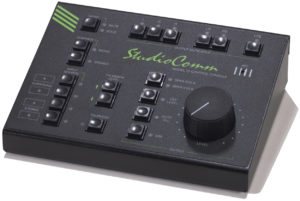Model 74 Central Controller
General Audio:
Frequency Response: 20 Hz-20 kHz ±0.1 dB (down 0.5 dB @ 60 kHz), monitor outputs
Distortion (THD+N): 0.04%, measured at 1 kHz, +4 dBu, monitor outputs
S/N Ratio: 87 dB, ref +4 dBu out, 20 Hz-20 kHz, monitor outputs
Crosstalk: 78 dB, typical, ref +4 dBu in, 20 Hz-20 kHz, monitor outputs
Audio Inputs: 16, organized as two 6-channel "5.1" inputs and two 2-channel "stereo" inputs
Type: electronically balanced, compatible with balanced or unbalanced sources
Impedance: 24 k ohms
Nominal Level: –12 dBV to +6 dBu, adjustable
Level Calibration: 15-turn trim potentiometers
Monitor Outputs: 2, 6-channel
Type: electronically balanced, compatible with balanced or unbalanced loads
Maximum Level: +27 dBu into 10 k ohms, +26 dBu into 600 ohms
Talent Amplifier Output:
Compatibility: provides power and audio signals for up to four Model 35 Talent Amplifiers
Type: DC power with two channels of unbalanced audio
Connections: common on pin 1, DC (+27 V nominal, 200 mA maximum) modulated with channel 1 audio (–10 dBu nominal) on pin 2, and channel 2 audio (–10 dBu nominal) on pin 3
Line-Level Cue Output: 1, stereo
Nominal Level: +4 dBu, nominal
Type: electronically balanced, capacitor-coupled, intended to drive balanced or unbalanced loads of 600 ohms or greater
Source Impedance: 100 ohms, nominal
Maximum Level: +20 dBu into 10 k ohms
Line-Level Talkback Input:
Level: +4 dBu, nominal
Type: electronically balanced
Impedance: 24 k ohms, nominal
Infrared Receiver Input:
Type: intended for use with industry-standard receiver module; data rate 650 baud
Remote Control Inputs: 4
Type: +5 Vdc logic, activates on closure to system common
Functions: mute, dim, talkback, input select
Downmix:
Functions: 5.1 to stereo, stereo to mono (mono-to-left-and-right, mono-to-center)
5.1 to Stereo: LS @ –3 dB summed with L; RS @ –3 dB summed with R, C @ –6 dB summed with L and R; LS, RS, and LFE monitor outputs mute
Stereo to Mono (Mono-to-Left-and-Right): L summed with R to L and R or L summed with R to C; attenuation independently configurable; C, LS, RS, and LFE monitor outputs mute
Stereo to Mono (Mono-to-Center): L summed with R to C; attenuation independently configurable; L, R, LS, RS, and LFE monitor outputs mute
Stereo to Mono (Mono-to-Center) Bandpass Filter:
Response: –3 dB @ 100 Hz and 5 kHz, nominal, 12 dB/octave
Connectors:
Audio: 4, 25-pin D-subminiature female
Talent Amplifier Output: 3-pin male XLR-type
To/From Model 75: 9-pin D-subminiature female
Remote Control Inputs: 9-pin D-subminiature female
Infrared Receiver Input: 3.5 mm 3-conductor jack
AC Mains: 3-blade, IEC 320 C14-compatible (mates with IEC 320 C13)
AC Mains Requirement: 100, 120, or 220/240 V, ±10%, factory configured, 50/60 Hz, 26 watts maximum
Dimensions (Overall):
19.0 inches wide (48.3 cm)
1.72 inches high (4.4 cm)
9.58 inches deep (24.3 cm)
Mounting: one space (1U) in a standard 19-inch rack
Weight: 9.5 pounds (4.3 kg)
Model 75 Control Console
Application: supports Model 74 Central Controller
Power: provided by Model 74 Central Controller
Output Data: generates MIDI system-exclusive messages
Connector: 9-pin D-subminiature female
Dimensions (Overall):
7.2 inches wide (18.3 cm)
2.2 inches high (5.6 cm)
5.4 inches deep (13.7 cm)
Weight: 1.8 pounds (0.82 kg)
Model 35 Talent Amplifier
Power Requirements: +20-32 Vdc (modulated with left channel audio), provided by Model 74
Power Present LED: red, indicates presence of operating power
Connectors:
Input (from Model 74): 3-pin XLR-type, female
Loop Thru: 3-pin XLR-type, male, connected in parallel with input connector
Headphone Outputs: 2, ¼ -inch, 3-conductor (stereo) phone jacks
Headphone Output: 1, feeds two headphone jacks
Load: intended for connection to one or two pairs of headphones with total impedance of 75 ohms or greater
Output Level: user adjustable
Maximum Output Voltage: 16 Vpp into 150 ohms @ 1% THD+Noise, 400 Hz
Distortion (THD+N): 0.03%
Frequency Response: 20 Hz-20 kHz ±0.5 dB
Dimensions (Overall):
4.2 inches wide (10.7 cm)
2.0 inches high (5.1 cm)
5.3 inches deep (13.5 cm)
Mounting: desktop; microphone stand mounting adapter included
Weight: 0.8 pounds (0.4 kg)
Specifications subject to change without notice.









